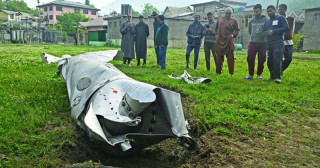Night_Hawk
Siasat.pk - Blogger
یہ پھل گرمیوں میں موٹاپے سے نجات کے لیے مددگار


موسم گرما کی شدت میں اضافے کے ساتھ ہی گرمیوں کے پھل بھی ملنا شروع ہوجاتے ہیں۔
یہ موسم اپنے رنگارنگ پھلوں کی وجہ سے جانا جاتا ہے جیسے آم، تربوز، آلوبخارے، خوبانی، آڑو، فالسے اور لیچی۔
اور اگر آپ موٹاپے سے نجات چاہتے ہیں تو یہ موسم مثالی وقت ثابت ہوسکتا ہے کیونکہ زیادہ پسینہ بہنے اور صبح جلداٹھنے میں آسانی سے ہٹ کر رنگارنگ غذائیں اس مقصد کو آسان بناتی ہیں۔
اور لیچی موٹاپے اور توند سے نجات کے لیے اس لیے فائدہ مند ہے کیونکہ اس میں کیلوریز نہ ہونے کے برابر ہیں جبکہ صحت کے لیے فائدہ مند اجزا بہت زیادہ ہیں۔
تاہم ذیابیطس کے مریضوں کو یہ پھل ڈاکٹر کے مشورے سے استعمال کرنا چاہئے کیونکہ اس میں مٹھاس موجود ہوتی ہے۔
اور ہاں اس پھل کو اعتدال میں ہی کھانا چاہئے جیسے روزانہ 10 سے 12، اس سے زیادہ نہیں۔
جسمانی وزن میں کمییہ موسم اپنے رنگارنگ پھلوں کی وجہ سے جانا جاتا ہے جیسے آم، تربوز، آلوبخارے، خوبانی، آڑو، فالسے اور لیچی۔
اور اگر آپ موٹاپے سے نجات چاہتے ہیں تو یہ موسم مثالی وقت ثابت ہوسکتا ہے کیونکہ زیادہ پسینہ بہنے اور صبح جلداٹھنے میں آسانی سے ہٹ کر رنگارنگ غذائیں اس مقصد کو آسان بناتی ہیں۔
اور لیچی موٹاپے اور توند سے نجات کے لیے اس لیے فائدہ مند ہے کیونکہ اس میں کیلوریز نہ ہونے کے برابر ہیں جبکہ صحت کے لیے فائدہ مند اجزا بہت زیادہ ہیں۔
تاہم ذیابیطس کے مریضوں کو یہ پھل ڈاکٹر کے مشورے سے استعمال کرنا چاہئے کیونکہ اس میں مٹھاس موجود ہوتی ہے۔
اور ہاں اس پھل کو اعتدال میں ہی کھانا چاہئے جیسے روزانہ 10 سے 12، اس سے زیادہ نہیں۔
یہ پھل موٹاپے اور توند سے نجات میں فائدہ مند ہے جس کی وجہ اس میں موجود فائبر اور دیگر اجزا ہیں۔ جسمانی وزن کم کرنے کے دوران ایسی غذاﺅں اور پھلوں کی ضرورت ہوتی ہے جو چربی گھلانے میں مدد دے سکیں اور لیچی اس میں مددگار پھل ہے۔
نظام ہاضمہچونکہ اس میں فائبر موجود ہے تو اسے ہضم کرنا آسان ہوتا ہے، جسمانی وزن میں کمی کی کوششوں میں ایک بڑا مسئلہ قبض کا ہوسکتا ہے جس کی وجہ غذا میں فائبر کی مناسب مقدار نہ ہونا ہوتی ہے۔ تو صحت مندانہ جسمانی وزن میں کمی کے لیے یہ پھل فائدہ مند ہے اور نظام ہاضمہ بہتر ہونے سے غذاﺅں کو ہضم کرنا بھی آسان ہوجاتا ہے۔
بلڈ پریشر
لیچی پوٹاشیم سے بھرپور پھل ہے جبکہ اس میں سوڈیم کی مقدار بہت کم ہوتی ہے، جس سے بلڈ پریشر کی سطح متوازن رہتی ہے۔ بلڈ پریشر کے شکار افراد میں کولیسٹرول کی سطح بڑھنے سے موٹاپے کا امکان بڑھتا ہے، لیچی کھانے سے اس مسئلے سے بچا جاسکتا ہے۔
مضبوط جسمانی دفاعی نظاماگر جسمانی دفاعی نظام کمزور ہو تو اس سے بھی جسمانی وزن میں اضافہ ہوتا ہے، لیچی جسم کے مدافعتی نظام کو مضبوط بنانے کے لیے مفید پھل ہے جس کی وجہ اس میں موجود وٹامنز اور منرلز ہیں۔
- Featured Thumbs
- https://i.dawn.com/large/2018/05/5aef1d5368da8.jpg










































